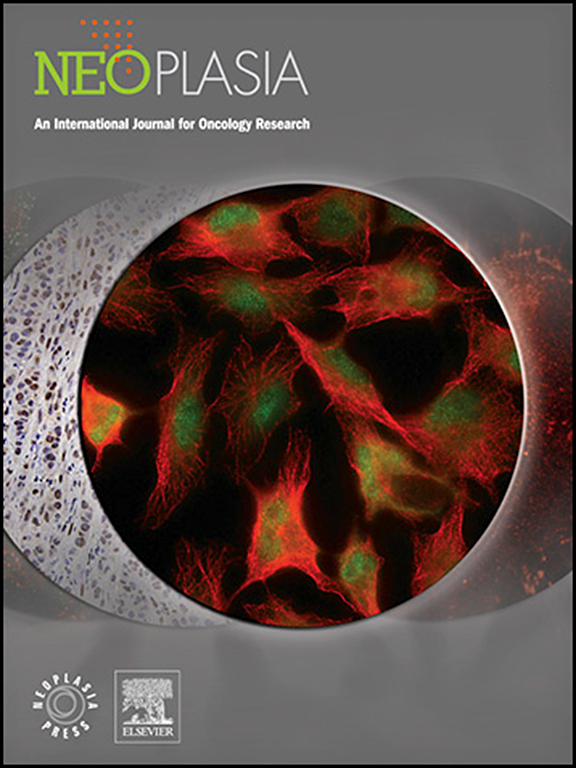degrasyn 对 USP14 的抑制可诱导 YAP1 降解并抑制耐放射性食管癌的进展。
IF 4.8
2区 医学
Q1 Biochemistry, Genetics and Molecular Biology
引用次数: 0
摘要
背景:放疗是食管癌(ESCA)治疗的主要方式,但放射抗性严重影响了其疗效。泛素特异性肽酶 14(USP14)是一种新型的去泛素化酶,可介导癌细胞对辐照的反应,但其潜在机制仍不清楚,包括在食管癌中:为了评估 USP14 在 ESCA 组织或细胞中的表达情况,我们使用了 RNA-Seq、免疫印迹、共免疫沉淀(Co-IP)、泛素化、实时定量聚合酶链反应(qRT-PCR)和免疫荧光检测等方法。此外,我们还使用了 CCK8、克隆和迁移试验来检测 ESCA 细胞的增殖和迁移。我们还利用移植肿瘤小鼠模型来研究癌细胞的生长过程。最后,我们利用基因组富集分析(GSEA)研究了与 USP14 相关的生物学过程,并进行了验证:结果:我们观察到 USP14 在人类 ESCA 组织和细胞系中明显上调,尤其是在具有放射抗性的组织和细胞系中。此外,敲除 USP14 能明显抑制 ESCC 细胞的增殖并抑制其辐射耐受性。在这里,我们发现了USP14的潜在抑制剂Degrasyn(DGS),并研究了它对ESCCA放射抗性和进展的调控作用。我们发现,DGS 对辐射敏感的 ESCA 细胞系有明显的抗增殖作用。值得注意的是,低剂量的DGS能显著增强耐放射ESCA细胞对辐照的敏感性,表现为细胞增殖、迁移和侵袭明显减少。此外,DGS 和 X 射线照射的组合通过增加 H2AX(γ-H2AX)的磷酸化水平和检查点激酶 1/ataxia-telangiectasia-mutated-and-Rad3-related kinase(CHK1/ATR)信号转导,强烈诱导耐放射ESCA细胞系的DNA损伤。动物实验证实,DGS 和 X 射线联合疗法能有效降低 ESCA 在体内的肿瘤生长和辐照耐受性,且毒性检测不到。重要的是,USP14 的过表达几乎消除了 DGS/X 射线联合治疗所抑制的 ESCA 细胞的促进性和恶性生物学行为,同时 DNA 损伤过程也被废除。从机理上讲,我们发现 USP14 可与 Yes-associated protein 1 (YAP1) 相互作用,并诱导其在抗放射 ESCA 细胞中去泛素化。有趣的是,我们发现 DGS/X 射线联合疗法能显著降低 YAP1 的稳定性,并诱导其在耐放射性 ESCA 细胞中泛素化。更重要的是,在耐放射ESCA细胞中过表达YAP1时,DGS/X-射线和USP14敲除所调控的增殖、上皮-间充质转化(EMT)过程和DNA损伤均明显消失:这些数据揭示了 DGS/X 射线联合疗法通过抑制 USP14/YAP1 轴在控制 ESCA 放射治疗耐药性方面的潜在作用,为 ESCA 治疗提供了一种候选策略。本文章由计算机程序翻译,如有差异,请以英文原文为准。

USP14 inhibition by degrasyn induces YAP1 degradation and suppresses the progression of radioresistant esophageal cancer
Background
Radiotherapy is a major modality for esophageal cancer (ESCA) treatment, yet radioresistance severely hampers its therapeutic efficacy. Ubiquitin-specific peptidase 14 (USP14) is a novel deubiquitinase and can mediate cancer cells’ response to irradiation, although the underlying mechanism remains unclear, including in ESCA.
Methods
To evaluate the expression of USP14 in ESCA tissues or cells, we used RNA-Seq, immunoblotting, co-immunoprecipitation (Co-IP), ubiquitination, quantitative real-time polymerase chain reaction (qRT-PCR), and immunofluorescence assays in this investigation. Additionally, we used CCK8, cloning, and migration tests to examine the proliferation and migration of ESCA cells. We also used transplantation tumor mouse model to investigate the course of the cancer cell growth. Finally, we looked into the biological processes linked to USP14 using gene set enrichment analysis (GSEA), which was later verified.
Results
We observed a significant upregulation of USP14 in human ESCA tissues and cell lines, especially in those with radioresistance. Moreover, USP14 knockdown significantly restrained the proliferation and inhibited the radiation tolerance of ESCC cells. Here, we identified a potential inhibitor of USP14, Degrasyn (DGS), and investigated its regulatory effects on ESCA radioresistance and progression. We found that DGS had marked antiproliferative effects in radiosensitive ESCA cell lines. Notably, a low dose of DGS significantly enhanced the sensitivity of radioresistant ESCA cells to irradiation, as shown by the significantly reduced cell proliferation, migration, and invasion. Furthermore, the combination of DGS and X-ray irradiation strongly induced DNA damage in radioresistant ESCA cell lines by increasing the phosphorylation levels of H2AX (γ-H2AX) and checkpoint kinase 1/ataxia-telangiectasia-mutated-and-Rad3-related kinase (CHK1/ATR) signaling. Animal experiments confirmed the effective role of the DGS and X-ray combined treatment in reducing tumor growth and irradiation tolerance of ESCA in vivo with undetectable toxicity. Importantly, the promotive and malignant biological behaviors of ESCA cells suppressed by the DGS/X-ray combination treatment were almost eliminated by USP14 overexpression, along with the abolished DNA damage process. Mechanistically, we found that USP14 could interact with Yes-associated protein 1 (YAP1) and induce its deubiquitination in radioresistant ESCA cells. Interestingly, we discovered that DGS/X-ray co-therapy significantly reduced the stability of YAP1 and induced its ubiquitination in radioresistant ESCA cells. More importantly, the proliferation, epithelial-mesenchymal tansition (EMT) process, and DNA damage regulated by DGS/X-ray and USP14 knockdown were significantly eliminated when YAP1 was overexpressed in radioresistant ESCA cells.
Conclusions
These data revealed the potential role of DGS/X-ray co-therapy in controlling ESCA resistance to radiotherapy by inhibiting the USP14/YAP1 axis, providing a candidate strategy for ESCA treatment.
求助全文
通过发布文献求助,成功后即可免费获取论文全文。
去求助
来源期刊

Neoplasia
医学-肿瘤学
CiteScore
9.20
自引率
2.10%
发文量
82
审稿时长
26 days
期刊介绍:
Neoplasia publishes the results of novel investigations in all areas of oncology research. The title Neoplasia was chosen to convey the journal’s breadth, which encompasses the traditional disciplines of cancer research as well as emerging fields and interdisciplinary investigations. Neoplasia is interested in studies describing new molecular and genetic findings relating to the neoplastic phenotype and in laboratory and clinical studies demonstrating creative applications of advances in the basic sciences to risk assessment, prognostic indications, detection, diagnosis, and treatment. In addition to regular Research Reports, Neoplasia also publishes Reviews and Meeting Reports. Neoplasia is committed to ensuring a thorough, fair, and rapid review and publication schedule to further its mission of serving both the scientific and clinical communities by disseminating important data and ideas in cancer research.
 求助内容:
求助内容: 应助结果提醒方式:
应助结果提醒方式:


